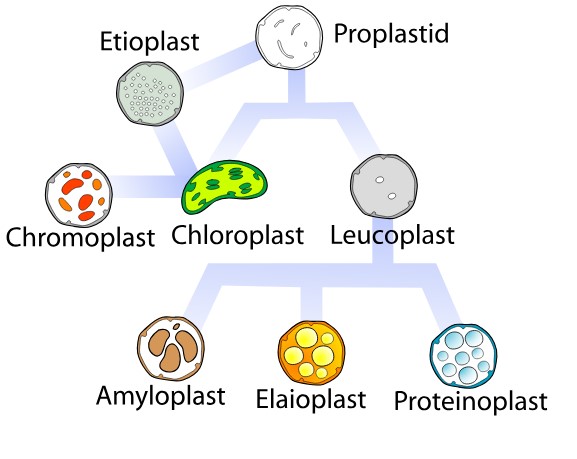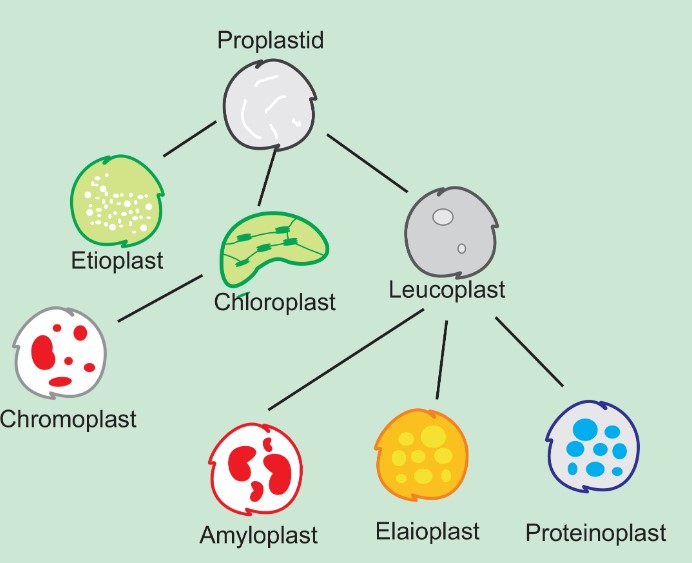Plastids are essential components within the cells of plants and algae, serving a variety of functions that are pivotal for cellular metabolism, growth, and development. Among the diverse types of plastids, aleuroplasts and elaioplasts stand out due to their specific roles in storing vital biological compounds. These organelles, while less known than their photosynthetic counterpart, the chloroplast, play critical roles in the life of a plant cell.
Aleuroplasts and elaioplasts are specialized types of plastids with distinct functions: aleuroplasts are primarily involved in the storage of proteins, whereas elaioplasts are focused on the storage of oils and lipids. This functional distinction underpins their importance in various plant physiological processes, including germination and the synthesis of essential oils.
Given their crucial roles, understanding the differences between aleuroplasts and elaioplasts offers insights into plant cellular biology’s complexities. These organelles’ structure, function, and presence across different plant tissues highlight the intricate mechanisms plants have evolved to store and utilize essential biochemicals. This knowledge not only deepens our appreciation of plant biology but also opens avenues for biotechnological applications in agriculture, food industry, and beyond.

Plastids Overview
Types and Functions
Plastids are key organelles in plant cells, crucial for numerous functions that sustain life. They are known for their versatility and ability to differentiate into various types, each serving unique roles within the plant cell.
Definition and Role
At their core, plastids are membrane-bound structures that carry out a range of functions, from photosynthesis to the storage of essential nutrients. They are essentially the manufacturing and storage centers of plant cells, contributing to growth, development, and survival.
Common Types
Several common types of plastids include:
- Chloroplasts: Sites of photosynthesis, converting light energy into chemical energy.
- Chromoplasts: Responsible for pigment synthesis and storage, giving fruits and flowers their vibrant colors.
- Leucoplasts: Colorless plastids involved in the storage of starches, oils, and proteins. Leucoplasts differentiate into more specific forms, such as amyloplasts (starch storage), elaioplasts (oil storage), and aleuroplasts (protein storage).
Aleuroplasts
Definition
Aleuroplasts are a type of leucoplast, specialized for the storage of proteins. Unlike chloroplasts, they do not participate in photosynthesis, but they play a critical role in seed development and germination.
Brief Description
Aleuroplasts are often found in seed cells, where they store seed storage proteins (SSPs). These proteins are crucial for the seed as they provide the necessary nutrients during germination and seedling growth.
Characteristics
Structure
The structure of aleuroplasts is adapted to their function of protein storage. They are typically rounded or oval in shape and contain numerous protein bodies.
Function
The primary function of aleuroplasts is to store proteins. These proteins are vital for the early stages of plant development, especially during germination when the plant relies on stored nutrients to grow.
Location in Cells
Aleuroplasts are predominantly located in seeds and embryonic tissues. Their presence is crucial for the development and growth of new plant life.
Elaioplasts
Definition
Elaioplasts are another type of leucoplast, specialized in the storage of oils and lipids. These plastids are essential for lipid storage and play a significant role in the synthesis of fatty acids and essential oils.
Brief Description
Found in non-photosynthetic tissues of plants, elaioplasts store lipids that can be used by the plant for various metabolic processes. They are especially common in oilseed plants and in tissues that produce essential oils.
Characteristics
Structure
Elaioplasts have a unique structure suited to storing lipids. They are equipped with a lipid-rich matrix and sometimes contain crystalline structures where lipids are stored.
Function
The main role of elaioplasts is to store lipids and oils. These stored lipids are crucial for energy production, membrane synthesis, and the creation of secondary metabolites, such as essential oils.
Location in Cells
Elaioplasts are typically found in cells of the flower, seeds, and fruits. Their location correlates with their role in storing lipids that are important for the plant’s reproduction and growth processes.

Key Differences
Structural Variations
Comparison of Structure
Aleuroplasts and elaioplasts, while both are types of leucoplasts, exhibit distinct structural variations. Aleuroplasts are typically characterized by their dense, protein-packed interior. These organelles may appear more granular under the microscope due to the presence of numerous protein bodies. On the other hand, elaioplasts are structured to accommodate lipid storage, often displaying a smoother interior with lipid droplets or sometimes crystalline structures where lipids are densely packed. These structural differences are directly tied to their functional roles within the plant cell.
Functional Distinctions
Differences in Function
The primary function of aleuroplasts is the storage of proteins, which are crucial during the germination process and early plant development. These proteins serve as a nutrient reservoir to support the plant’s growth when photosynthesis is not yet possible. Conversely, elaioplasts are focused on the storage of oils and lipids. These lipids are not just energy sources; they are also precursors for various biological molecules, including hormones and secondary metabolites crucial for the plant’s defense mechanisms and signaling.
Location and Occurrence
Cell Types and Locations
Aleuroplasts are predominantly found in seed cells and embryonic tissues, where their protein storage capabilities are most needed. In contrast, elaioplasts are commonly located in oilseed plants and parts of the plant that are involved in the synthesis of essential oils, such as flowers and sometimes leaves. This distribution underlines the specialized functions of each plastid type and their importance in different stages and parts of the plant.
Role in Plant Physiology
Aleuroplasts at Work
Specific Roles and Examples
Aleuroplasts play a pivotal role during seed germination. For example, in wheat seeds, aleuroplasts are responsible for storing gluten, which is a key protein supporting the growth of the seedling until it can produce its food through photosynthesis. Similarly, in legumes, these plastids store crucial proteins that are broken down into amino acids, serving as building blocks for the growing plant.
Elaioplasts in Action
Specific Roles and Examples
Elaioplasts are essential in plants that produce significant amounts of essential oils or lipids. In peppermint, for example, elaioplasts in the leaf cells store the precursors for menthol, which is synthesized and stored in the glandular trichomes of the leaves. This not only contributes to the plant’s aroma but also plays a role in protecting the plant from herbivores and pathogens.
Comparative Analysis
Similarities
Shared Traits and Functions
Despite their differences, aleuroplasts and elaioplasts share some fundamental traits. Both are types of leucoplasts, meaning they are non-photosynthetic and primarily involved in storage functions. They are critical for the plant’s developmental stages, especially in parts of the plant that do not undergo photosynthesis, by providing necessary nutrients or chemical precursors.
Unique Contributions
How Each Adds Value to the Plant Cell
While aleuroplasts and elaioplasts serve different purposes, each adds unique value to the plant cell. Aleuroplasts ensure that young plants have access to vital proteins at a stage when they cannot synthesize their proteins. This early nutrition is crucial for the development and survival of seedlings. On the other hand, elaioplasts contribute to the plant’s reproductive success and defense mechanisms by storing oils and lipids. These can be converted into various compounds, including volatile oils, which attract pollinators or act as deterrents against herbivores and pathogens.
Frequently Asked Questions
What are plastids?
Plastids are a group of membrane-bound organelles found in the cells of plants and algae. They are responsible for manufacturing and storing important chemical compounds used by the cell. Plastids have various forms, each with specific functions, including photosynthesis, storage of starches, proteins, and lipids, and the synthesis of many types of molecules essential for the plant.
How do aleuroplasts differ from other plastids?
Aleuroplasts are specialized for storing proteins, setting them apart from other plastids like chloroplasts, which are involved in photosynthesis, and amyloplasts, which store starch. Their unique protein storage capability is vital for seed development and germination, providing necessary nutrients during early plant growth stages.
Why are elaioplasts important in plants?
Elaioplasts play a crucial role in the storage of oils and lipids within plant cells. These lipids are not only structural components of membranes but also precursors for various biochemical processes, including hormone synthesis. Elaioplasts’ ability to store and supply lipids is essential for plant metabolism, growth, and the production of essential oils, contributing to both plant health and human uses such as aromatherapy and natural remedies.
Conclusion
Aleuroplasts and elaioplasts are pivotal in understanding the intricate web of plant physiology, offering a window into how plants manage resources at the cellular level. Their specialized functions in storing proteins, oils, and lipids underscore the evolutionary adaptations plants have developed to thrive in diverse environments. Appreciating the nuances between these plastids enriches our understanding of plant biology and highlights the importance of cellular organelles in overall plant health and development.
Furthermore, this knowledge fosters a greater appreciation for the complexity and efficiency of plant cells, emphasizing the potential for innovative applications in biotechnology, agriculture, and medicine. By exploring the unique roles of aleuroplasts and elaioplasts, we gain insights into the cellular mechanisms that support life, underscoring the beauty and sophistication of the natural world.

